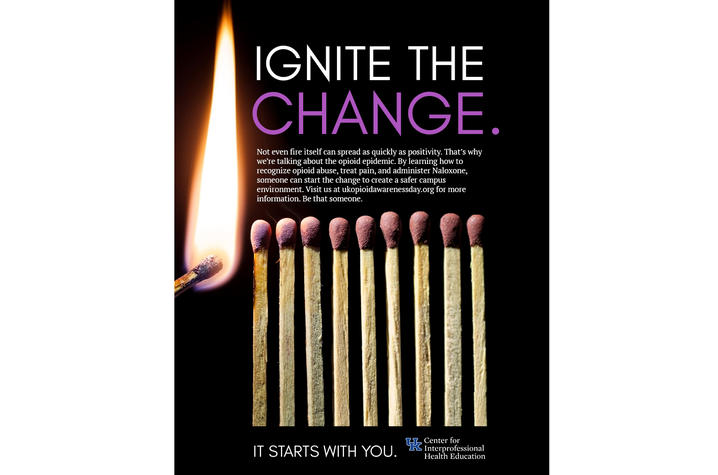ISC Department Faculty, Students Help Plan UK’s 1st Opioid Awareness Day

LEXINGTON, Ky. (July 2, 2020) — University of Kentucky's Department of Integrated Strategic Communication students in Naomi Maloney’s Spring 2020 Advertising Creative Strategy & Execution I class recently partnered with UK’s Center for Interprofessional Health Education (CIHE) to develop a campus and community‐wide Opioid Awareness Day (OAD). OAD, originally planned as a February 2020 event, has been rescheduled for September 2021 in the wake of COVID-19 cancellations.
OAD activities may range from one day to a week-long program, depending on Fall 2021 public health guidelines for the UK campus. Student-led activities proposed by the OAD team include a mobile pharmacy, a showcase of models for care and pain management, displays by Fayette County Fire and EMS teams, presentations on Kentucky’s Good Samaritan law, AMA ("Ask Me Anything") booths, access to Health Department and needle exchange materials and community panels featuring members of Operation UNITE and the Kentucky State Police Angel Initiative.
OAD is the brainchild of Neil Horsley, a UK College of Medicine M.D. candidate and president of MedRed, CIHE’s student association dedicated to fighting the substance use disorder epidemic in Kentucky. Horsley describes Opioid Awareness Day as “a campuswide effort to raise awareness of those suffering from substance use disorders (SUDs) both on campus and across our Commonwealth.” Horsley notes the importance of opioid awareness marketing that is “both intriguing and nonjudgmental in its approach.” He calls the efforts of Maloney and her students “tremendous,” adding that the ISC team members “reflect not only their dedication to helping those suffering from SUDs on campus and in our Commonwealth, but also demonstrate the incredible change that can be brought about when interprofessional education is utilized to its fullest extent. They are excellent ambassadors of both the Department of Integrated Strategic Communication and the College of Communication and Information as a whole.”
Maloney shares her collaborators’ enthusiasm for the partnership and its potential for opioid harm reduction in the Commonwealth. “It was empowering and gratifying for our ISC 331 students to develop advertising ideas that will engage their fellow UK students and convince them to participate in Opioid Awareness Day,” she says. “Not only did these ISC students learn more about opioid use disorder (OUD) and the stigma surrounding it, they were able to see how their talents have the potential to save lives. I am enormously proud of how seriously and creatively they approached the project and of the final advertising work they produced.”
Long before the coronavirus ravaged communities worldwide, UK and Commonwealth communities grappled with the impact of opioid use. Though the Kentucky Office of Drug Control Policy cites a peak of over 1,400 opioid-related deaths in 2017, the office also says there is cause for hope.
According to the Commonwealth of Kentucky Justice and Public Safety Cabinet: 2019 Overdose Fatality Report, "In 2018 ... the Commonwealth ...saw signs that the overall trend in overdose deaths may be changing direction. For the first time since 2013, overdose deaths among Kentucky residents declined, falling from 1,477 in 2017 to 1,247 last year — a 15 percent decrease equivalent to 230 lives. When the totals include individuals who died in Kentucky but were not residents, the decrease is similar — 1,566 in 2017 reduced to 1,333 in 2018, a decrease of 233 deaths."
The report attributes this decline to “a number of program and policy initiatives underway in Kentucky, including the statewide use of prescription drug monitoring programs, expanded availability of naloxone and substance abuse treatment, and the enactment of laws specifically addressing the availability of prescription medications.”
James A. Ballard — an OAD planning team member, director of the Center for Interprofessional Health Education, and associate professor in the UK Department of Family and Community Medicine — says initiatives like UK’s Opioid Awareness Day can contribute to this positive trend. “The health of patients and communities is impacted by so much more than the care they receive in clinics and hospitals. True health care, as opposed to disease care, calls for more expansive collaborations beyond the medical professions. I think all the students came away from this experience with a much deeper understanding of the power of working beyond silos and how it can positively impact individuals and communities.”
UK faculty and staff contributing to OAD planning include Shelley M. Ferrin (health education coordinator and IP education specialist, Center for Interprofessional Health Education), Kakie Urch (associate professor of Multimedia, School of Journalism and Media), as well as James Ballard and Maloney. The Executive Planning Committee members are Rachelle Aker, Madeline Aulisio, James Ballard and Shelley Ferrin (CIHE); Justin Blevins, Kenyatta Jeter and team (Residence Life); Trish Freeman and Doug Oyler (College of Pharmacy); Physical Therapy and Public Health students Nichole Windsor and William McIver; Chief Medical Officer Phil Chang; Katrina Nickels of Bluegrass Care Navigators; Andrea James of the Lexington Mayor’s Office; and Horsley and Michelle Lofwall of College of Medicine and MedRed.
The Department of Integrated Strategic Communication, part of the University of Kentucky College of Communication and Information, offers students professional preparation for careers in the areas of advertising, public relations and direct response communication. For more information or questions regarding ISC, please contact ISC Project Manager Amy Brooks at amy.brooks@uky.edu.
As the state’s flagship, land-grant institution, the University of Kentucky exists to advance the Commonwealth. We do that by preparing the next generation of leaders — placing students at the heart of everything we do — and transforming the lives of Kentuckians through education, research and creative work, service and health care. We pride ourselves on being a catalyst for breakthroughs and a force for healing, a place where ingenuity unfolds. It's all made possible by our people — visionaries, disruptors and pioneers — who make up 200 academic programs, a $476.5 million research and development enterprise and a world-class medical center, all on one campus.




